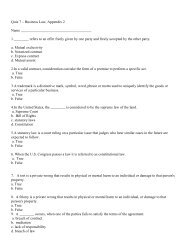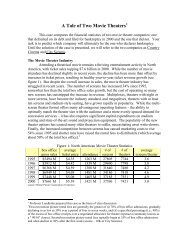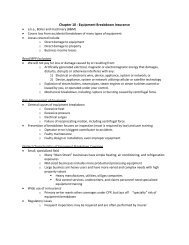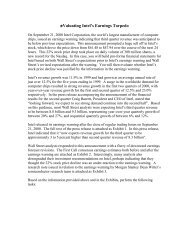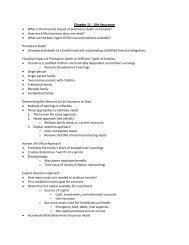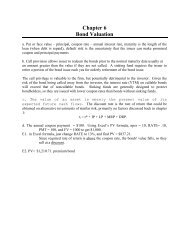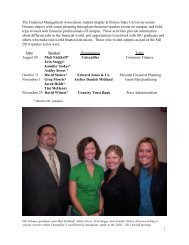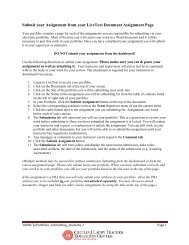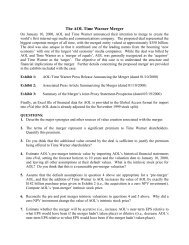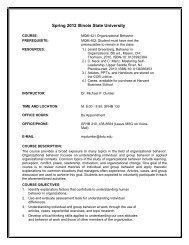Forecasting for the Love Boat: Royal Caribbean Cruises in 1998(
Forecasting for the Love Boat: Royal Caribbean Cruises in 1998(
Forecasting for the Love Boat: Royal Caribbean Cruises in 1998(
You also want an ePaper? Increase the reach of your titles
YUMPU automatically turns print PDFs into web optimized ePapers that Google loves.
GENERALThe growth <strong>in</strong> <strong>the</strong> Company's revenues dur<strong>in</strong>g <strong>the</strong> last three fiscal years has primarily been a function of <strong>the</strong> expansion of its fleetcapacity and, additionally <strong>in</strong> <strong>1998</strong>, its ability to obta<strong>in</strong> significantly higher net yields than <strong>in</strong> previous years.Fixed costs, <strong>in</strong>clud<strong>in</strong>g depreciation, fuel, <strong>in</strong>surance and crew costs, represent more than one-third of <strong>the</strong> Company's operat<strong>in</strong>gexpenses and do not change significantly <strong>in</strong> relation to changes <strong>in</strong> passenger loads and aggregate passenger ticket revenue.The Company's cruise and tour operations experience vary<strong>in</strong>g degrees of seasonality. The Company's revenue from <strong>the</strong> sale ofpassenger tickets <strong>for</strong> its cruise operations is moderately seasonal. Historically, demand <strong>for</strong> cruises has been greater dur<strong>in</strong>g <strong>the</strong>summer months. The Company's tour revenues are extremely seasonal with a majority of tour revenues generated dur<strong>in</strong>g <strong>the</strong> latespr<strong>in</strong>g and summer months <strong>in</strong> conjunction with <strong>the</strong> Alaska cruise season.The year over year percentage <strong>in</strong>crease <strong>in</strong> average passenger capacity <strong>for</strong> <strong>the</strong> Company's cruise brands, exclud<strong>in</strong>g <strong>the</strong> impact of<strong>the</strong> acquisition and consolidation of Cunard and Seabourn, is expected to be 13.7% dur<strong>in</strong>g fiscal 1999 as compared to fiscal <strong>1998</strong>.This <strong>in</strong>crease is primarily a result of <strong>the</strong> <strong>in</strong>troduction <strong>in</strong>to service of Carnival's Elation <strong>in</strong> March <strong>1998</strong> and Paradise <strong>in</strong> lateNovember <strong>1998</strong>, <strong>the</strong> expected <strong>in</strong>troduction <strong>in</strong>to service of <strong>the</strong> Carnival Triumph <strong>in</strong> July 1999 and Holland America's Volendam<strong>in</strong> August 1999 and <strong>the</strong> <strong>in</strong>troduction <strong>in</strong>to service of W<strong>in</strong>dstar's W<strong>in</strong>d Surf <strong>in</strong> May <strong>1998</strong>. Includ<strong>in</strong>g <strong>the</strong> impact of Cunard andSeabourn, average passenger capacity is expected to <strong>in</strong>crease 18.5% <strong>in</strong> fiscal 1999 as compared to fiscal <strong>1998</strong>. The acquisitionand consolidation of Cunard and Seabourn is not expected to materially affect <strong>the</strong> Company's consolidated net <strong>in</strong>come <strong>in</strong> 1999.The year over year percentage <strong>in</strong>crease <strong>in</strong> average passenger capacity, exclud<strong>in</strong>g <strong>the</strong> impact of Cunard and Seabourn, result<strong>in</strong>gfrom <strong>the</strong> delivery of vessels currently under contract <strong>for</strong> construction <strong>for</strong> <strong>the</strong> fiscal years 2000 and 2001 is expected toapproximate 12.9% and 11.9%, respectively. Includ<strong>in</strong>g <strong>the</strong> impact of Cunard and Seabourn, <strong>the</strong> year over year <strong>in</strong>crease <strong>in</strong>average passenger capacity <strong>for</strong> fiscal 2000 and 2001 is expected to approximate 11.7% and 10.9%, respectively.In June 1997, <strong>the</strong> Company and Airtours, a publicly traded leisure travel company <strong>in</strong> which <strong>the</strong> Company holds a 26% <strong>in</strong>terest,each acquired a 50% <strong>in</strong>terest <strong>in</strong> Il Ponte, <strong>the</strong> parent company of Costa, an Italian cruise company. The Company records its<strong>in</strong>terest <strong>in</strong> Airtours and Il Ponte us<strong>in</strong>g <strong>the</strong> equity method of account<strong>in</strong>g and records its portion of Airtours' and Il Ponte'sconsolidated operat<strong>in</strong>g results on a two-month lag basis. Demand <strong>for</strong> Airtours' and Costa's products is seasonal due to <strong>the</strong> natureof <strong>the</strong> European leisure travel <strong>in</strong>dustry and European cruise season. Typically, Airtours' and Costa's quarters end<strong>in</strong>g June 30 andSeptember 30 experience higher demand, with demand <strong>in</strong> <strong>the</strong> quarter end<strong>in</strong>g September 30 be<strong>in</strong>g <strong>the</strong> highest.Fiscal <strong>1998</strong> Compared To Fiscal 1997RevenuesThe <strong>in</strong>crease <strong>in</strong> total revenues of $561.8 million, or 23.0%, was due primarily to an <strong>in</strong>crease <strong>in</strong> cruise revenues of $540.3 million,or 23.9%. Approximately $281.9 million of <strong>the</strong> cruise revenue <strong>in</strong>crease is due to <strong>the</strong> acquisition and consolidation of Cunard andSeabourn and $258.4 million is due to <strong>in</strong>creased cruise revenues from Carnival, Holland America and W<strong>in</strong>dstar. The <strong>in</strong>creasefrom Carnival, Holland America and W<strong>in</strong>dstar resulted from an <strong>in</strong>crease of approximately 7.0% <strong>in</strong> total revenue per passengercruise day and a 4.8% <strong>in</strong>crease <strong>in</strong> passenger capacity, offset slightly by a .6% decrease <strong>in</strong> occupancy rates. Total revenue perpassenger cruise day <strong>in</strong>creased primarily due to strong demand <strong>for</strong> <strong>the</strong> Company's cruise brands and <strong>the</strong> <strong>in</strong>troduction of HollandAmerica's new Rotterdam VI <strong>in</strong> November 1997, which has obta<strong>in</strong>ed higher pric<strong>in</strong>g. Passenger capacity <strong>in</strong>creased due to <strong>the</strong>addition of new vessels discussed previously partially offset by <strong>the</strong> Ecstasy be<strong>in</strong>g out of service <strong>for</strong> two months dur<strong>in</strong>g <strong>1998</strong> (seeNonoperat<strong>in</strong>g Income (Expense)). Tour revenues <strong>in</strong>creased $31.8 million, or 13.1% to $274.5 million <strong>in</strong> <strong>1998</strong> from $242.6million <strong>in</strong> 1997 due primarily to an <strong>in</strong>crease <strong>in</strong> <strong>the</strong> number of tours sold.Cost and ExpensesOperat<strong>in</strong>g expenses <strong>in</strong>creased $296.7 million, or 22.4%. Cruise operat<strong>in</strong>g costs <strong>in</strong>creased by $274.2 million, or 23.1% <strong>in</strong> <strong>1998</strong>.Approximately $177.5 million of <strong>the</strong> cruise operat<strong>in</strong>g costs <strong>in</strong>crease is due to <strong>the</strong> acquisition and consolidation of Cunard andSeabourn. Exclud<strong>in</strong>g Cunard and Seabourn, cruise operat<strong>in</strong>g costs as a percentage of cruise revenues were 50.9% and 52.5% <strong>in</strong><strong>1998</strong> and 1997, respectively. Cruise operat<strong>in</strong>g costs, exclud<strong>in</strong>g Cunard and Seabourn, <strong>in</strong>creased primarily as a result of <strong>in</strong>creases<strong>in</strong> passenger capacity and airfare costs, partially offset by lower fuel costs. Airfare costs <strong>in</strong>creased due to a higher rate per airpassenger as well as a higher percentage of passengers elect<strong>in</strong>g <strong>the</strong> Company's air program. Tour operat<strong>in</strong>g expenses <strong>in</strong>creased$32.8 million, or 17.2% primarily due to <strong>the</strong> <strong>in</strong>crease <strong>in</strong> tour volume and higher expenses <strong>in</strong>curred primarily as a result of<strong>in</strong>creased tour content.Sell<strong>in</strong>g and adm<strong>in</strong>istrative expenses <strong>in</strong>creased $72.9 million, or 24.6%, of which $46.8 million, or 15.8%, was due to <strong>the</strong>acquisition and consolidation of Cunard and Seabourn. Exclud<strong>in</strong>g Cunard and Seabourn, sell<strong>in</strong>g and adm<strong>in</strong>istrative expenses as apercentage of revenues were 11.8% and 12.1% <strong>in</strong> <strong>1998</strong> and 1997, respectively. Sell<strong>in</strong>g and adm<strong>in</strong>istrative expenses, exclud<strong>in</strong>gCunard and Seabourn, <strong>in</strong>creased primarily as a result of <strong>in</strong>creases <strong>in</strong> advertis<strong>in</strong>g and payroll and related costs.



